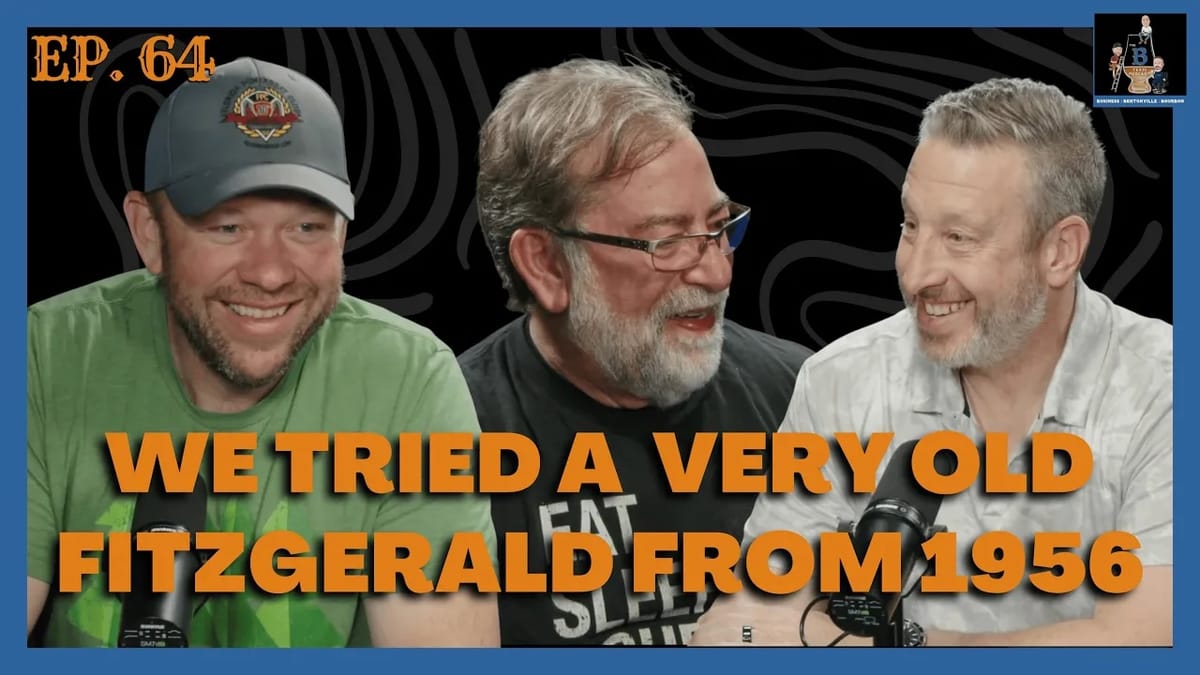What if you could taste bourbon exactly as it was made half a century ago? Not a modern recreation, but the actual liquid that was distilled, aged, and bottled during a completely different era of American whiskey production?
Stephen, known online as the Dusty Whiskey Hunter, joined us to open a remarkable window into bourbon's past through his collection of vintage decanters and bottles. These aren't just interesting containers – they're time machines containing whiskey made using methods, grains, and aging environments that simply no longer exist.
The tasting journey begins with Ezra Brooks decanters shaped like phonographs, chess pieces, and antique stock tickers – each containing bourbon distilled in the 1960s and 70s. As we sample a 12-year Ezra Brooks and move to a Jim Beam "Bonded Beams" from 1968-1979, the differences between vintage and modern bourbon become stunningly apparent. The rich, complex flavors with notes of roasted corn, cornbread, and baking spices leave everyone at the table agreeing that these dusty whiskeys deliver something impossible to find on today's shelves.
The highlight arrives when Stephen shares his prized Very Old Fitzgerald from 1956, distilled at the legendary Stitzel-Weller distillery and bottled in 1964. This extraordinary wheated bourbon, worth approximately $3,000 on the secondary market, stands as perhaps the finest whiskey any of us have ever tasted – a liquid artifact from bourbon's golden age that no amount of modern expertise can recreate.
Beyond the tasting, Stephen offers invaluable insights for collectors on authenticating vintage bottles through tax stamps and proper seals, along with guidance on reasonable price points for those looking to begin their own dusty whiskey journey. As Russ explains, "We cannot replicate this history... no matter what money we have."
Follow @DustyWhiskeyHunter on Instagram or email DustyWhiskeyHunter@gmail.com to learn more about these fascinating liquid time capsules that preserve bourbon's rich heritage one bottle at a time.
More About this Episode
The Allure of Dusty Bourbon: History, Art, and the Unmatched Taste of America's Past
There’s something undeniably magical about pouring a glass of whiskey that predates your parents. It’s a journey not just through taste but through time. On this week’s episode, we dove deep into the world of dusty bourbon - those forgotten bottles tucked away in basements, attics, and estate sales that are not only drinkable but, in many cases, exceptional.
Whether you're a seasoned whiskey aficionado or a curious newcomer, understanding the history and significance behind these older expressions can fundamentally change your appreciation for America’s native spirit. Here’s everything we unpacked - from collectible decanters and flavor profiles to buying tips and holy grails in the dusty whiskey world.
What Exactly Is a Dusty Bourbon?
“Dusty” bourbons refer to bottles typically produced and bottled prior to the 1990s - some going back as far as the 1940s or even earlier. These aren’t just relics for display; many of them contain rich, mellow, and complex whiskey that rivals or outshines today's top-shelf offerings.
Bourbon laws and aging practices were different decades ago. Bottled-in-bond whiskey was far more common, and producers often aged their product for 8, 12, or even 15 years as standard practice. Combine that with decades of bottle aging, and you have a spirit with layers of depth and smoothness that today’s bottles often struggle to replicate.
From Ezra Brooks to Jim Beam: The Standouts
One of the most enjoyable pours of the episode was a 12-year Ezra Brooks, clocking in at 90 proof. This bourbon offered a balanced flavor profile with roasted corn and barrel-driven smokiness, not peated like a Scotch, but rich with American oak influence. It’s a sleeper bottle, underrated in the market and an ideal day-to-day sipper for those who favor approachable proof with deep complexity.
Jim Beam also made a strong appearance in the form of a Bonded Beam - 100 proof, aged 8 years, and distilled in 1968 before being bottled in 1979. The red mahogany color alone hinted at its richness. On the nose and palate, notes of caramel, roasted nuts, and dried fruits set it apart from anything currently on liquor store shelves.
And then came the Holy Grail: a Very Old Fitzgerald, distilled in 1956 and bottled in 1964. Made by the legendary Stitzel-Weller distillery, this bottled-in-bond, 100-proof weeded bourbon had the room collectively awestruck. Think dark fruit, cinnamon, vanilla pudding, and velvety softness. It wasn’t just a drink - it was an experience.
Decanters as Functional Art
What makes collecting dusty bourbon so compelling isn’t just what’s inside the bottle - it’s also the artistry outside. From the Old Crow Chessmen, made with handmade porcelain molds, to the whimsical Lionstone decanters, many of these bottles are literal works of art. Some came with promotional pamphlets inviting owners to exclusive bottle clubs, giving these items even more historical value.
The bourbon itself was often uniform across decanters within the same product line, but each vessel told a different story - be it through form, theme, or craftsmanship. Today, collectors scour markets for specific chess pieces or limited-release decanters, often paying hundreds of dollars for the bottle alone, juice aside.
Flavors You Can’t Find Anymore
Dusty bourbon has a distinctive flavor profile that modern distilling methods often can’t replicate. Lower entry proofs into barrels, longer aging cycles, and non-chill filtration techniques all contributed to richer, more nuanced flavors.
For example, today's whiskey might hit you with a blast of ethanol or oak upfront, but a dusty pour gently unfolds with roasted corn, dark baking spices, marzipan, or clove. As Stephen, our in-house dusty bourbon expert, shared: “You can’t replicate this history. Even with all the money in the world, you can’t blend or craft what we drank today.”
How to Start Collecting and Drinking Dusty Bourbon
If you're ready to dive into the dusty bourbon world, start with brands like Lionstone or Jim Beam. They're relatively affordable and widely available on the secondary market, often priced between $80–$150. Lionstone, in particular, offers a vast array of decanters and consistent quality.
For newcomers, here are a few tips to avoid counterfeit or degraded bottles:
- Look for Tax Strips: Until the early 1980s, all bottles included a tax stamp across the top. Red means not bonded, green usually indicates bottled-in-bond.
- Check for Leaks: Turn the bottle upside down briefly to ensure the seal is intact.
- Match the Capsule: Make sure the closure matches historical photos and isn’t a recent replacement.
- Assess Fill Levels: Significant evaporation could mean oxidation has occurred, which can ruin the flavor.
- Buy from Reputable Sources: If it seems too good to be true, it probably is. Talk to seasoned collectors or reach out to resources like DustyWhiskeyHunter on Instagram.
The Bourbon Community: Sharing, Not Hoarding
Perhaps the most beautiful part of dusty bourbon culture is the spirit of sharing. As Stephen put it, “Bourbon is for sharing.” These bottles were never meant to sit untouched on a shelf for eternity. They’re time capsules meant to be opened, savored, and discussed with friends.
Even the rarest bottles - like that 1956 Very Old Fitzgerald - found their way into glasses around the table. Because what’s the point of owning something so special if not to create unforgettable experiences with others?
Why Dusty Bourbon Matters
At the heart of our dusty bourbon exploration is this realization: today’s whiskey world owes everything to the craftsmanship of the past. The richness, complexity, and warmth found in these older bottles remind us that whiskey isn’t just a drink - it’s a cultural artifact.
So the next time you're at an estate sale, your grandparent’s basement, or scrolling through a bourbon Facebook group, keep your eyes peeled. You might just find a dusty gem that redefines everything you thought you knew about bourbon.
And remember, as we learned on this journey, it's not about the price or rarity - it’s about the story, the experience, and the people you share it with.


Member discussion: